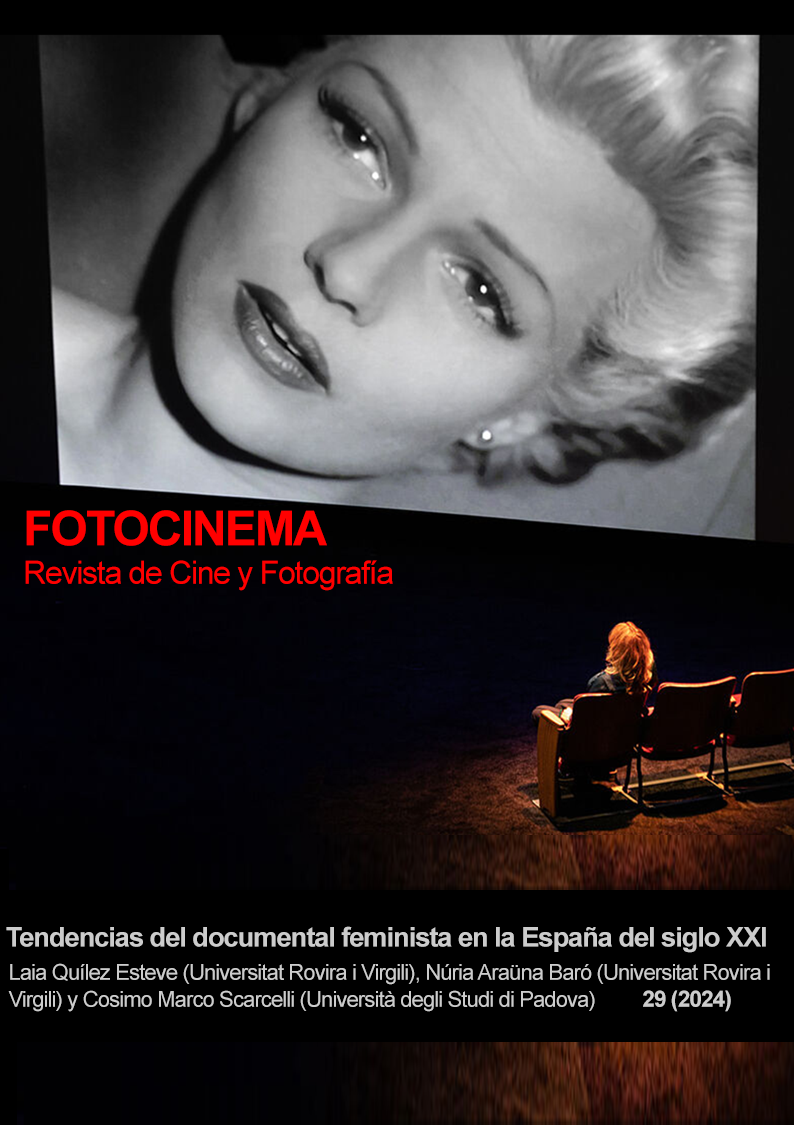Fíos Fóra: sewing, precariousness and emancipation. The paradox of women in the Galician textile industry.
La paradoja de las mujeres en la industria textil gallega.
DOI:
https://doi.org/10.24310/fotocinema.29.2024.19628Keywords:
Militant documentary film, Women, Social reality, Collective Statement, Fashion documentary, DressmakersAbstract
The social and cultural relationship between women and sewing goes back a long way, also in the field of work. Economists, sociologists and feminists have left us witnesses of what happened in Anglo-Saxon workshops and factories in the 19th century. Testimonies that, as we shall see, could be describing the situation in Galicia in the 20th century or in Bangladesh, Cambodia or India today.
With this article we want to analyse the 2015 documentary Fíos Fóra. Historias de obreiras, entre costuras e patrones (Threads Outside. Stories of workers, between seams and patterns) directed by the Galician collective Illa Bufarda. This film is part of a trend that has been revived after the financial crisis of 2008, in which the directors focus on the working conditions of the working class and vindicate the role of women in the economy. We will see how it moves away from the most common themes in fashion documentaries and the differences it introduces in the treatment of the subject.
Downloads
Metrics
Publication Facts
Reviewer profiles N/A
Author statements
Indexed in
-
—
- Academic society
- N/A
- Publisher
- Universidad de Málaga
References
Alonso Logroño, M.P.; Rodríguez González R. (2005). Territorio en mutación: la industria textil-confección como factor de desarrollo local en Galicia. Anales de Geografía, 25. 137-162.
Castelló Mayo, E. (2019). Filmar o traballo. En M. Ledo Andión (Coord.), Para unha historia do cinema en lingua galega 2. A foresta e as árbores (pp. 95-115). Galaxia.
Buck-Morss, S. (2001). Dialéctica de la mirada. Walter Benjamin y el proyecto de los Pasajes. A. Machado Libros.
Campbell, J. (2020). El héroe de las mil caras. Atalanta.
Armstrong, D. (1983-1984). Wiseman's Model and the Documentary Project: Towards a Radical Film Practice. Film Quaterly, 37(2). 2-10.
Edwards, L. (2022). Only the clothes on her back: Clothing and the Hidden History of Power in the Nineteenth-Century United States [e-book]. Oxford University Press.
Flügel, J.C. (2015). Psicología del vestido. Melusina
Godinho, P. (2017). Presas por um fio: costureiras de Verín, modalidades da produção tèxtil local e trânsitos mundiais. En P. Tomé Martín (Ed.) Reflexiones Rayanas vol 1 (pp. 103-125). Asociación de Antropología Castilla y León Michael Kenny.
Greenberg, J. (1968-1969). Interview with Robert Aldrich. Sight & Sound, 38(1). 8-13.
Harris, B. (2016). Famine and Fashion: Needlewomen in the Nineteenth Century [e-book]. Routledge.
Hubert, P.G. (1894). Occupations for Women. En AA.VV. The Woman's Book vol.1. Charles Scribner's Sons, pp. 1-76.
Khan, M. (2013, 27 de noviembre). Grandes historias 2013: el derrumbe en Bangladesh que sacudió la industria textil. BBC News. Recuperado de: https://www.bbc.com/mundo/noticias/2013/12/131127_grandes_historias_2013_edificio_bangladesh_yv
Lipovetsky, G. (2016). De la ligereza [e-book]. Anagrama.
Martínez Barreiro, A. (1998). Mirar y hacerse mirar: la moda en las sociedades modernas. Tecnos.
Mies, M. (2019). Patriarcado y acumulación a escala mundial [e-book]. Traficantes de Sueños.
Miranda, J.A.; Roldán, A. (2021). Inditex y la ventaja competitiva de la fast fashion española, 1985-2019. Dimensioni e Problemi della Ricerca Storica, 2, 155-178.
Otero González, U. (2021). Domesticando cuerpos femeninos en el franquismo (1939-1975): la (re)modelación de la feminidad normativa y su encarnación sartorial en la transición de los cincuenta [tesis doctoral]. Universidade de Santiago de Compostela.
Pérez Pena, M. (2015, 13 noviembre). El modelo del textil gallego se reprodujo en otros países aprovechando situaciones de pobreza. El Diario. Recuperado de: https://www.eldiario.es/galicia/gallego-reprodujo-aprovechando-situaciones-pobreza_1_2406950.html
Prada Rodríguez, J. (2022). Los talleres de costura para el Ejército sublevado en Galicia (1936-1939). Historia Contemporánea, 69, 545-576.
Potter Webb, B. (1888). Pages from a Work Girl’s Diary. The Nineteenth Century, 24(139). 301-314.
Simmel, G. (2014). Filosofía de la moda. Casimiro.
Veblen, T. (2010). Teoría de la clase ociosa [e-book]. Fondo de Cultura Económica.
Downloads
Published
How to Cite
Issue
Section
License
Copyright (c) 2024 Ana Pérez Valdés

This work is licensed under a Creative Commons Attribution-NonCommercial-NoDerivatives 4.0 International License.
All contents published in Fotocinema Revista científica de cine y fotografía are protected under the Creative Commons Attribution-NonCommercial-ShareAlike 4.0 International (CC BY-NC-SA 4.0) license. All about this license is available in the following link: <http://creativecommons.org/licenses/by-nc-sa/4.0>
Users can copy, use, redistribute, share and exhibit publicly as long as:
- The original source and authorship of the material are cited (Journal, Publisher and URL of the work).
- It is not used for comercial purposes.
- The existence of the license and its especifications are mentioned.
There are two sets of authors’ rights: moral and property rights. Moral rights are perpetual prerogatives, unrenounceable, not-transferable, unalienable, imprescriptible and inembargable. According to authors’ rights legislation, Fotocinema. Revista científica de cine y fotografía recognizes and respects authors moral rights, as well as the ownership of property rights, which will be transferred to University of Malaga in open access. The property rights are referred to the benefits that are gained by the use or the dissemination of works. Fotocinema. Revista científica de cine y fotografía is published in an open access form and it is exclusively licenced by any means for doing or authorising distribution, dissemination, reproduction, , adaptation, translation or arrangement of works.
Authors are responsable for obtaining the necessary permission to use copyrighted images.














13.png)



